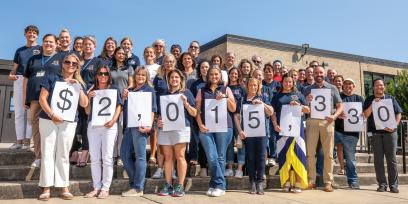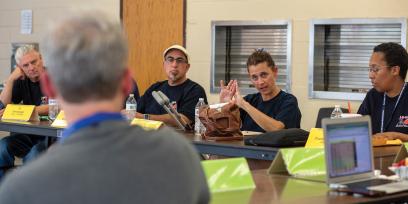T
he Half Hollow Hills Teachers’ Association (HHHTA), my local union, turned 50 this year. In that half century of representing thousands of members, and with the support of a strong union movement in New York, we have negotiated for the rights and wages that recognize the professional work our members do every day. Like any other local, of course, what we’ve been able to deliver in any given contract was a function of bargaining context: Did we have strong support in the community? How were our relationships with leaders at all levels of the district? What did settlements in the area look like? And, of course, what was the economic reality when we were at the table?
Even after 13 years of negotiating through contracts, evaluation plans, and a pandemic, I’m still amazed by what a struggle it is to add or remove something from the contract and how the difference between “crushing it” and just clearing the 50 percent mark to ratify can come down to small, seemingly symbolic wins and losses. Even in the best of times, contracts can live or die on relatively thin margins, like the difference between a 3 percent raise and a 3.5 percent raise.
For several years, we weren’t in the best of times. In 2011, New York state passed a law capping property taxes, which put a ceiling on one of our schools’ two main funding streams. That ceiling forced districts to pivot how they built their budgets, which in turn impacted negotiations. In the years that followed, contract settlements included lots of financial givebacks and freezes. When there were gains, they were nothing like members had been accustomed to, so we faced razor-thin margins for ratification. In the early 2010s, a union leader fighting for a good contract could get dragged from the table kicking and screaming over the difference between adding 0.5 percent or 0.6 percent to a salary schedule.
Thanks to fierce advocacy at the state and local levels, our unions worked through some of those hardest initial years and settled into a new normal. That meant engaging in statewide advocacy for school funding and getting better at thinking outside the box about how to continue to deliver value for our members and make their lives better. In our local, we used one-on-one conversations, surveys, registration data, social media participation, and email response and click rates to examine our members’ interests, priorities, and common needs. Although we saw a variety of needs, one jumped out: hundreds of our 800 teacher members—including me—were still carrying overwhelming student debt.
We had committed to helping our members tackle their student debt years before. A team of union leaders had explored that work, beginning with a trip to New Jersey, where the AFT was hosting a student debt clinic. Our first endeavor into solving the student debt crisis in the HHHTA, however, turned out to be what some today would call a great, big “nothingburger.” Thanks to all the loopholes, inconsistencies, and failed promises in the federal government and student loan servicing worlds, not one member was able to achieve any form of forgiveness. Disappointed, we moved on to projects that were more promising for helping our members.
Fortunately, while the issue of organizing around student debt relief sat inert on our union’s wish list, the AFT was taking legal action on behalf of public employees who had been misled and cast aside by a failed Public Service Loan Forgiveness (PSLF) program. In July 2019, the AFT filed suit against then–Education Secretary Betsy DeVos and the US Department of Education. Two years later, on October 12, 2021, the US Department of Education and the AFT settled Weingarten v. DeVos, creating a window of opportunity to tackle massive amounts of debt carried by public service employees—including our members.
Following the settlement, the AFT held a telephone town hall and shared the great news about the extended waiver period that was being opened to allow potentially hundreds of thousands of employees who were otherwise ineligible to now qualify for public service loan forgiveness. Our executive board and building representatives were excited but also skeptical. The only thing more frustrating for our members than still paying student loans after decades of work, we agreed, would be to think that those loans were going to be forgiven and be denied again.
To avoid subjecting our members to that frustration, our local put together a pilot group. At a representative council meeting that fall, we solicited volunteers from a group of roughly 60 elected union leaders. Five of us would go through the process of applying for forgiveness, and based on our results, we’d decide whether to launch a union-wide campaign. The AFT had partnered with Summer, a company that helps steer borrowers through the processes of consolidating and applying for forgiveness. We shared the news and our pilot plan with members, then submitted our applications by November.
We waited through Thanksgiving. We waited through New Year’s. We checked our mailboxes, inboxes, junk mail folders, and student loan dashboards daily. Nothing happened… until it did. In early February, one after the other, we started receiving emails and letters indicating that our balances had been reduced to zero. The five of us who participated in the pilot had a total of roughly $164,000 in student loans forgiven.
Maximizing Our Impact
We immediately sprang into action, again sharing the news with members and developing a plan to ensure we maximized our reach. We agreed to an important organizing principle when we started. While it might be acceptable or expected to “miss” a member with any other given campaign—like missing a phone banking opportunity, for instance—it was not acceptable to miss a member in this effort. Failing to follow up—repeatedly, if necessary—could literally cost a member tens of thousands of dollars. In a time when contracts were decided by mere tenths of a percent, we also agreed that there may never be another single campaign in which we could have a greater financial impact for our members than this one.
We had from February 2022 until the waiver window closed in October 2022 to reach everyone, and we needed a comprehensive approach. It wasn’t enough just to reach members with the good news through a flyer and emails or to have building reps knock on classroom doors and check names off a roster to confirm each member they talked to about the opportunity—although we did all of those things. We had to lead and support each member through the process. So in addition to launching an aggressive ground game, we leveraged digital tools in our local to track and facilitate our work.
We leveraged our member database, online survey tools, web forms, text messaging, and dynamic emailing to keep hundreds of people moving toward debt relief. At the beginning, we administered a web-based survey to identify members who carried student debt. The credibility our union leaders have with members and the personal success stories we shared—not to mention the prospect of saving thousands of dollars—contributed to a high participation rate in the survey. That digital survey fed responses directly into our member database, where we were able to track progress and facilitate communication.
As members worked through their applications, they were in constant communication with our building representatives, executive board, and participants in the pilot. We talked them through their applications and kept updated records of the process in our systems. Based on members’ status in the application journey, we scheduled automated, customized reminders. At one point, members reported login difficulties with Summer; with the AFT’s support, we were able to upload and share unique login links with every member, allowing them faster access to the Summer system.
Sharing the Journey
Many factors contributed to this successful campaign, including the AFT’s tenacity and victory in the lawsuit; the constant support of AFT staff; the strong relationships within our local, which helped members feel comfortable talking about financial issues; and the digital infrastructure we had in place. But one of the most galvanizing and mobilizing forces we experienced in our work was our union’s sense of being on a shared journey.
When we began our campaign, we set a goal to have $1 million in student debt forgiven for our members by the end of 2022. Based on the number of responses and the average balances we saw, that number felt both ambitious and attainable. Every time a member achieved forgiveness, they’d email us or stop us in the hall to let us know. We’d update our system and use our digital tools to let members know that we “fed the pig”—our emailed campaign updates included piggy bank clip art with the total amount saved written across its belly. It was fun to watch the number grow. In each message, the updated total was presented alongside a note from our executive board about how many more members had just received the good news and any updates or clarifying guidance coming our way.
The shared journey, we think, gave members a sense of real hope in something they otherwise might have been too skeptical to pursue, and it motivated others to act as well. It became impossible to sit on the sidelines when the teacher across the hall came in Tuesday morning beaming over getting $20,000 forgiven, and success stories popped up throughout all our schools. When we stopped counting in late 2023, we had helped our members have over $2 million in student debt forgiven.
Collectively, we know that if it weren’t for the HHHTA and the advocacy and support we have at all levels of the AFT, none of this would have happened. We believe that the single mom who was paying $1,000 a month in student loans won’t ever forget that, nor will the handful of our members who had six-figure balances forgiven or those taking on debt to send their children to school while they were still paying down their own educations.
Recently, we had the opportunity to share the impact of PSLF on our hardworking teachers and school-related professionals with the US Department of Education, and I used our experiences to help negotiate new debt relief regulations for the Biden-Harris administration. Working alongside coalition partners, we hope to carve a path to forgiveness for more Americans so they too can cast off the shackles of their debt sentence.
Unionism is about using our collective strengths and abilities to fight for members to have better lives. To do that, it’s important for leaders to go the extra mile in finding out what members need. Sometimes that process will generate small campaigns that have big impact. Sometimes they kick off a yearslong crusade. In either case, we all win. Aside from the great pride that comes from delivering a victory for our friends and colleagues, every campaign we mobilize makes us stronger.
[photos: Pamela Wolfe]
Richard Haase is the president of the Half Hollow Hills Teachers’ Association on Long Island and has taught middle school English language arts in the Half Hollow Hills Central School District for more than 20 years.



